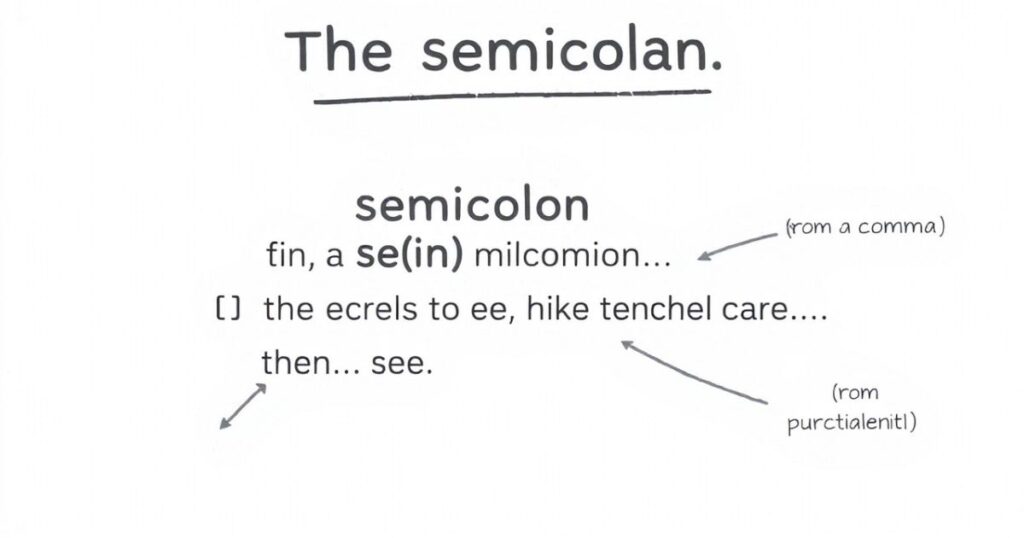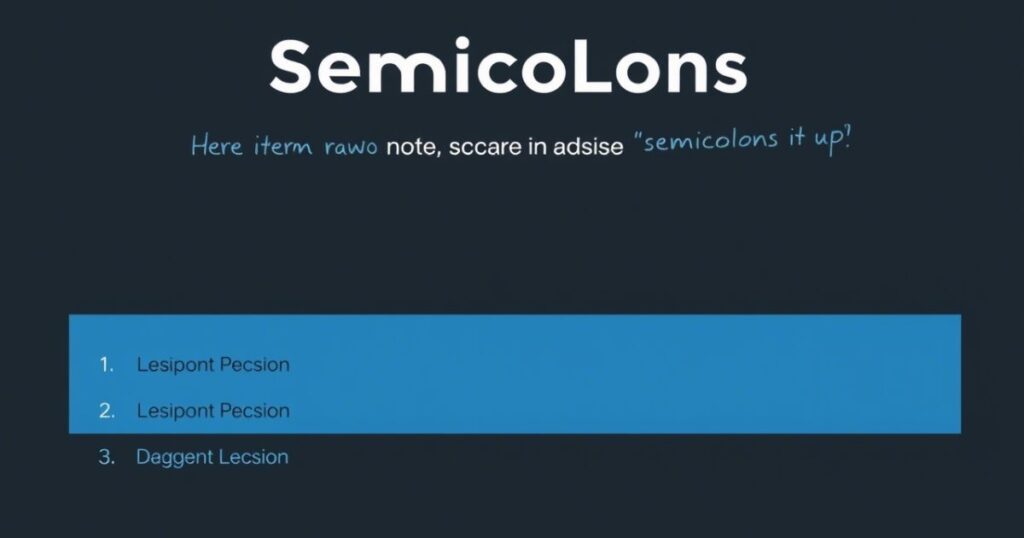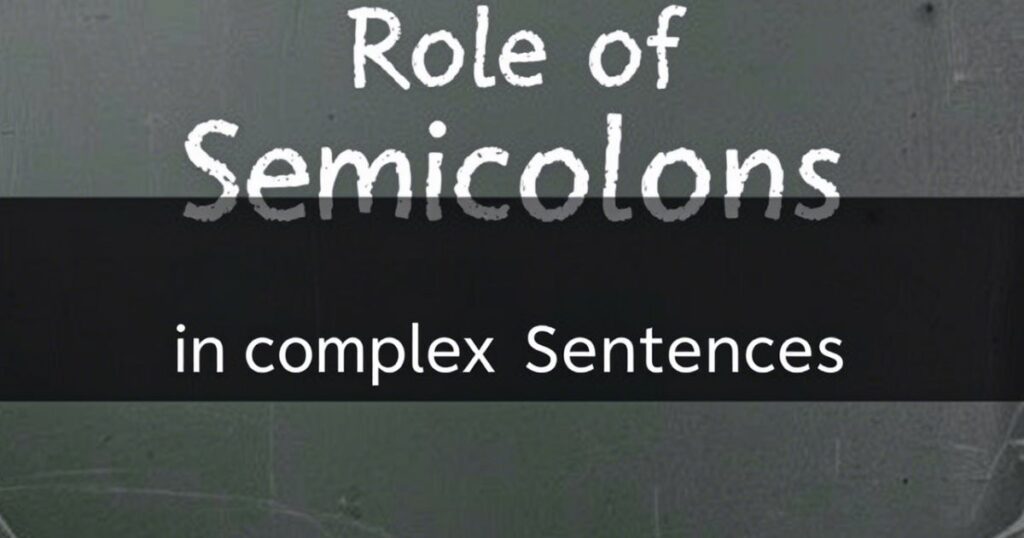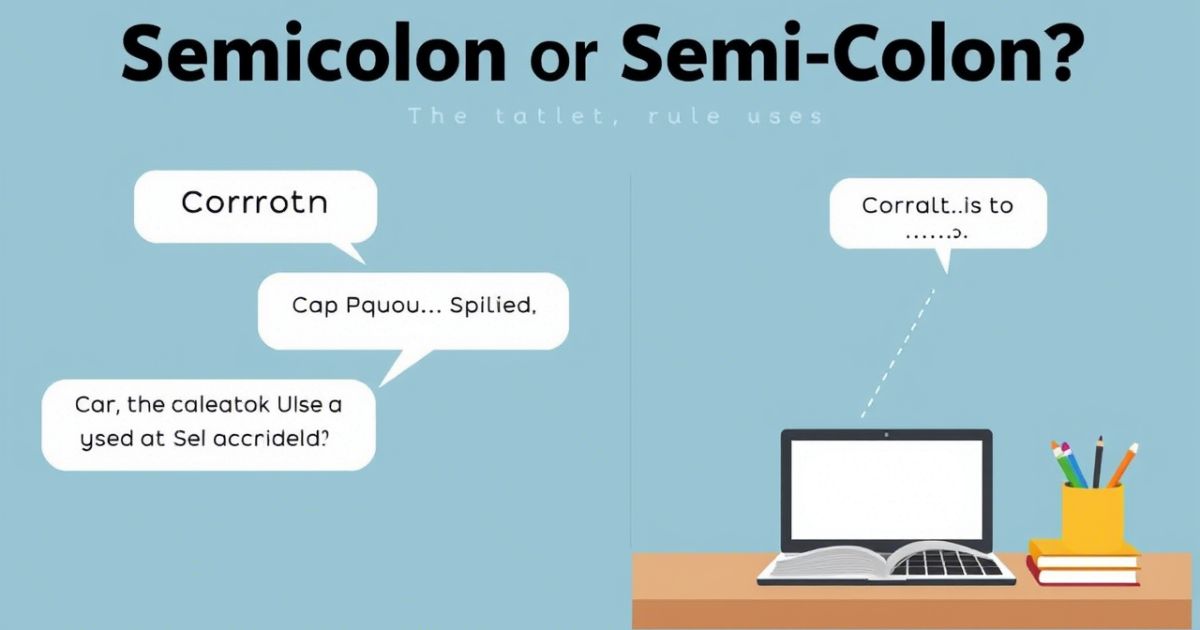Punctuation can make or break your writing, and one mark that often causes confusion is the semicolon. You might be wondering, “Should I use ‘semicolon or semi-colon‘?” or even questioning whether it’s “semi colon or semicolon.” The truth is, the correct form is “semicolon,” and understanding how to use it properly can elevate your writing significantly.
It’s easy to get tripped up on variations like “semi-co” or “simi colin,” but these are incorrect. The semicolon isn’t just a quirky punctuation mark – it plays a key role in connecting related ideas for smoother, more impactful sentences. So, let’s clear up the confusion and dive into how to use a “semicolon or semi-colon” the right way, and make your writing clearer and more professional.
Why Is There Confusion?
Confusion around the semicolon or semi-colon often stems from its nuanced role in English grammar. Unlike a period or comma, the semicolon sits in a gray area, stronger than a comma, yet not quite a full stop.
Many writers struggle to understand when to use it, especially with independent clauses, transitional phrases, or complex lists. The overlap with other punctuation marks like the colon or comma only adds to the uncertainty.
What Is a Semicolon?

A semicolon (;) is a punctuation mark used to link closely related independent clauses without a conjunction. It creates a pause stronger than a comma but weaker than a period, helping to maintain flow and clarity in writing. This unique role makes it ideal for improving sentence structure and avoiding run-on sentences.
In grammar guides semicolon or semi-colon and style manuals, semicolons are also recommended for organizing complex lists, especially when items already contain commas. For example: “We visited Paris, France; Rome, Italy; and Berlin, Germany.” This usage prevents confusion and enhances text clarity, making the semicolon a powerful tool in modern English.
“Semicolon” or “Semi-Colon:” The Correct Spelling
Both “semicolon or semi-colon” are understood, but “semicolon”, without the hyphen, is the standard spelling in American English and widely accepted in British English as well. The hyphenated form is considered outdated, appearing mostly in historical spelling or older orthographic treatises.
The Preferred Spelling: “Semicolon”
Modern English favors the single-word form “semi colon or semicolon” aligning with current language standards and style manuals. Dictionaries like Merriam-Webster and the Oxford English Dictionary list “semicolon” as the primary spelling. This reflects the language evolution from earlier British conventions toward more streamlined usage.
Why “Semi-Colon” Is Outdated
The hyphenated form “semi-colon” has largely fallen out of use due to changes in writing conventions and orthographic treatises over time. As grammar guides and style manuals updated with modern standards, the cleaner, compound form “semicolon” became dominant. The shift reflects the natural language evolution toward simplicity and consistency in the English language.
What About “Semi Colon”?
The version “semi colon,” written with a space, is grammatically incorrect and not supported by any language standards. Unlike hyphenated words that occasionally transition into compound forms, this spaced variation has never been accepted in English grammar. The only correct form is “semicolon”, a single, unbroken word. Using “semi colon” can lead to text clarity issues and is discouraged in both academic and professional writing.
When to Use a Semicolon
Use a semicolon to connect independent clauses that are closely related but not joined by a conjunction. It’s also essential for organizing complex lists where items contain internal commas, improving clarity and flow in sentence structure.
Related Guide:
Up to Date or Up-to-Date: Which One Should You Use?
Connecting Related Independent Clauses
A semicolon or semi-colon can link two closely related independent clauses, providing a smooth connection between thoughts. Both clauses should be complete sentences that could stand alone, but the semicolon shows their close relationship without needing a conjunction like “and” or “but.”
Example:
“She loves reading books; it helps her relax after a long day.”
In this example, the semicolon joins two complete ideas, highlighting their connection while keeping the sentence brief and to the point.
Clarifying Complex Lists

A semicolon is helpful for organizing complex lists, especially when items within the list contain commas. It ensures clarity by separating each list item more distinctly, preventing confusion between elements.
Example:
“The conference will include speakers from Paris, France; Berlin, Germany; and Tokyo, Japan.”
In this case, the semicolon separates each city-country pair, making the list easier to read and understand.
Linking Clauses with Transitional Phrases
A semicolon can also be used to connect independent clauses that are linked by transitional phrases such as “for example,” “however,” or “therefore.” This maintains the flow between ideas while signaling a relationship between them.
Example:
“She loves playing the piano; however, she doesn’t practice as often as she’d like.”
Here, the semicolon connects two related thoughts, with “however” acting as the transitional phrase that shows contrast.
Avoiding Run-On Sentences
A semicolon can be used to prevent run-on sentences by clearly separating two related independent clauses. This ensures that each thought is expressed properly while maintaining a smooth connection between them.
Example:
“I wanted to go for a walk; it started raining.”
The semicolon separates the two ideas, preventing a run-on sentence and helping the reader follow the thought process more easily.
When Not to Use a Semicolon
A semicolon or semi-colon should not be used when separating dependent clauses or when a conjunction like “and,” “but,” or “so” is already present. It’s also inappropriate for separating items in simple lists, where commas should be used instead for clarity.
Between an Independent Clause and a Dependent Clause: If the second part of the sentence is a dependent clause, use a comma instead of a semicolon.
Example: “She enjoys reading because it relaxes her,” not “She enjoys reading; because it relaxes her.”
Before a Coordinating Conjunction: Don’t place a semicolon before coordinating conjunctions like “and,” “but,” “or,” and “so.” A comma should be used instead.
Example: “I wanted to go out, but it started to rain,” not “I wanted to go out; but it started to rain.”
In Simple Lists: When listing items that don’t require complex separation, stick to commas. Semicolons aren’t necessary in simple lists.
Example: “She bought apples, oranges, and bananas,” not “She bought apples; oranges; and bananas.”
Between Two Related Clauses with a Conjunction: When using conjunctions like “because” or “if,” a semicolon is unnecessary. A comma is better.
Example: “He went home because he was tired,” not “He went home; because he was tired.”
When the Sentence is Short and Clear: If the sentence is short and clear, a semicolon can be overkill. Use a period or a comma for a cleaner structure.
Example: “She studied hard. She passed the exam.” not “She studied hard; she passed the exam.”
“Colon” vs. Semicolon
Although both the colon and semicolon are used to connect thoughts, they serve different roles. A colon (:) introduces further explanation, lists, quotes, or elaborates on what’s been stated, signaling that the following information expands on or clarifies the idea before it.
For example: “Her aim was simple: to make a difference.” Conversely, a semicolon (;) joins two closely linked independent clauses without the use of a conjunction, providing a smooth transition between them. For instance: “He trained hard; his commitment paid off.” While a colon directs attention to more details, a semicolon ties two ideas together, allowing them to remain distinct but connected.
Etymology of “Semicolon”
The word “semicolon” traces its roots back to the Greek word “semikolon,” meaning “half” (semi) and “clause” (kolon). The punctuation mark of semi-colon or semicolon was introduced into the English language in the 15th century, first appearing in Italian texts.
Its purpose was to signify a pause longer than a comma but shorter than a period, effectively bridging two independent clauses. The term “semicolon” reflects its role in connecting ideas in a way that’s more significant than a comma but not as final as a period.
Common Mistakes with Semicolon Usage
One common mistake is using a semicolon or semi-colon when a comma is needed, especially between an independent and a dependent clause. For example, writing “She went to the store; because she needed food” is incorrect. Instead, a comma should be used: “She went to the store because she needed food.”
Another mistake is using a semi-colon or semicolon to separate items in a simple list. Semicolons are typically reserved for complex lists with internal commas. Lastly, some writers misuse semicolons to join unrelated ideas. Semicolons should only connect closely related independent clauses, not ideas that aren’t linked in meaning.
The Role of Semicolons in Complex Sentences

Semicolon or Semi-colon play a crucial role in connecting closely related independent clauses within complex sentences. They help maintain clarity by joining thoughts that are linked, without the need for conjunctions like “and” or “but.” For example, “She loves to read; he enjoys writing.” The semicolon smoothly ties these two independent clauses together, showing their relationship without making the sentence too long or cumbersome.
This technique enhances the flow of the sentence and prevents it from becoming a run-on. Additionally, semicolons help in separating elements of a complex list, ensuring the sentence remains clear and easy to read.
FAQ’s
When should I use a colon or semicolon?
“You should use a colon to introduce a list, explanation, or quotation. Use a semicolon or semi-colon when connecting two related independent clauses without a conjunction.”
What is the difference between (;) and (:) in punctuation?
“The semicolon or semi-colon (;) links related independent clauses, while the colon (:) introduces lists, explanations, or further details. They serve different purposes in writing.”
What is the semicolon (;) used for?
“The semicolon or semi-colon (;) is used to join two closely related independent clauses. It helps to clarify the connection between two ideas without using a conjunction.”
What does (;) mean?
The semicolon (;) is a punctuation mark that connects two independent clauses or separates items in a complex list. It shows a closer relationship between the ideas than a period.
Is it correct to write “semi-colon” instead of “semicolon”?
No, “semi-colon” is an outdated and incorrect spelling. The correct form is “semicolon,” written as one word without a hyphen.
Conclusion
The correct spelling is “semicolon” rather than “semi-colon” or “semi colon.” The “semicolon or semi-colon” debate is simply a matter of using the proper form. While “semi-colon or semicolon” was once accepted, modern English favors the single-word version. It’s essential to remember that using the right punctuation, like “semicolon or semi-colon,” can improve clarity in your writing.
Avoid mixing up “simi colin” or “semi co” with the correct spelling. The semicolon serves a specific purpose in connecting ideas, and using it correctly ensures your writing flows smoothly. So, whether you write “semicolon or semi-colon,” make sure you use the right form to keep your sentences clear and precise.

Ember Rose is a dedicated administrator with 4 years of experience in efficient operations management and team leadership. Skilled in streamlining workflows and enhancing productivity.

